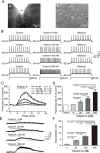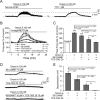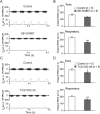Orexin A activates hypoglossal motoneurons and enhances genioglossus muscle activity in rats
- PMID: 24846570
- PMCID: PMC4241090
- DOI: 10.1111/bph.12784
Orexin A activates hypoglossal motoneurons and enhances genioglossus muscle activity in rats
Abstract
Background and purpose: Orexins have been demonstrated to play important roles in many physiological processes. However, it is not known how orexin A affects the activity of the hypoglossal motoneuron (HMN) and genioglossus (GG) muscle.
Experimental approach: GG muscle electromyograms (GG-EMG) were recorded in anaesthetized adult rats after orexin A or orexin receptor antagonists were applied to the hypoglossal nucleus, and in adult rats in which orexin neurons were lesioned with the neurotoxin orexin-saporin (orexin-SAP). HMN membrane potential and firing were recorded from neonatal rat brain slices using whole-cell patch clamp after an infusion of orexin A or orexin receptor antagonists.
Key results: Unilateral micro-injection of orexin A (50, 100 or 200 μM) into the hypoglossal nucleus significantly enhanced ipsilateral GG activity in adult rats. Orexin A (4, 20, 100 or 500 nM) depolarized the resting membrane potential and increased the firing rate of HMNs in a dose-dependent manner in the medullary slices of neonatal rats. Both SB 334867, a specific OX1 receptor antagonist and TCS OX2 29, a specific OX2 receptor antagonist not only blocked the depolarized membrane potential and the increased firing rate of HMNs by orexin A in the neonatal model but also attenuated GG-EMG in the adult model. A significant decrease in GG-EMG was observed in adult orexin neuron-lesioned rats compared with sham animals.
Conclusion and implications: Orexin A activates OX1 and OX2 receptors within the hypoglossal motor pool and promotes GG activity, indicating that orexin A is involved in controlling respiratory motor activity.
© 2014 The British Pharmacological Society.
Figures





Similar articles
-
Diverse physiological properties of hypoglossal motoneurons innervating intrinsic and extrinsic tongue muscles.J Neurophysiol. 2019 Nov 1;122(5):2054-2060. doi: 10.1152/jn.00478.2019. Epub 2019 Sep 18. J Neurophysiol. 2019. PMID: 31533009 Free PMC article.
-
Orexins depolarize rostral ventrolateral medulla neurons and increase arterial pressure and heart rate in rats mainly via orexin 2 receptors.J Pharmacol Exp Ther. 2010 Aug;334(2):522-9. doi: 10.1124/jpet.110.167791. Epub 2010 May 21. J Pharmacol Exp Ther. 2010. PMID: 20494957
-
Varied ionic currents underlie functional diversity of hypoglossal motoneurons innervating the superior longitudinalis and genioglossus tongue muscles.J Physiol. 2025 May;603(10):3181-3199. doi: 10.1113/JP288599. Epub 2025 May 11. J Physiol. 2025. PMID: 40349324
-
Orexin in sleep, addiction and more: is the perfect insomnia drug at hand?Neuropeptides. 2013 Dec;47(6):477-88. doi: 10.1016/j.npep.2013.10.009. Epub 2013 Oct 23. Neuropeptides. 2013. PMID: 24215799 Review.
-
Orexins/hypocretins: pain regulation and cellular actions.Curr Pharm Des. 2010;16(28):3089-100. doi: 10.2174/138161210793292483. Curr Pharm Des. 2010. PMID: 20687883 Review.
Cited by
-
Orexin and Central Modulation of Cardiovascular and Respiratory Function.Curr Top Behav Neurosci. 2017;33:157-196. doi: 10.1007/7854_2016_46. Curr Top Behav Neurosci. 2017. PMID: 27909989 Review.
-
Early improvement in obstructive sleep apnea and increase in orexin levels after bariatric surgery in adolescents and young adults.Surg Obes Relat Dis. 2017 Jan;13(1):95-100. doi: 10.1016/j.soard.2016.05.023. Epub 2016 May 30. Surg Obes Relat Dis. 2017. PMID: 27720196 Free PMC article.
-
Prevalence and Factors Associated with Rapid Eye Movement-Related Obstructive Sleep Apnea in Patients with Narcolepsy.Nat Sci Sleep. 2025 Aug 25;17:1929-1944. doi: 10.2147/NSS.S554593. eCollection 2025. Nat Sci Sleep. 2025. PMID: 40896258 Free PMC article.
-
Neuroanatomical Basis of State-Dependent Activity of Upper Airway Muscles.Front Neurol. 2018 Sep 10;9:752. doi: 10.3389/fneur.2018.00752. eCollection 2018. Front Neurol. 2018. PMID: 30250449 Free PMC article. Review.
-
Whole-Brain Monosynaptic Inputs to Hypoglossal Motor Neurons in Mice.Neurosci Bull. 2020 Jun;36(6):585-597. doi: 10.1007/s12264-020-00468-9. Epub 2020 Feb 24. Neurosci Bull. 2020. PMID: 32096114 Free PMC article.
References
-
- Azhdari-Zarmehri H, Esmaeili MH, Sofiabadi M, Haghdoost-Yazdi H. Orexin receptor type-1 antagonist SB-334867 decreases morphine-induced antinociceptive effect in formalin test. Pharmacol Biochem Behav. 2013;112:64–70. - PubMed
-
- Berger AJ, Bayliss DA, Viana F. Development of hypoglossal motoneurons. J Appl Physiol. 1996;81:1039–1048. - PubMed
Publication types
MeSH terms
Substances
LinkOut - more resources
Full Text Sources
Other Literature Sources
Miscellaneous

